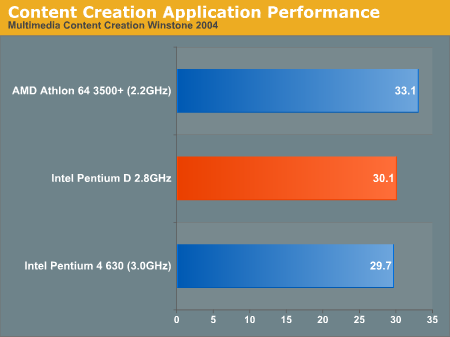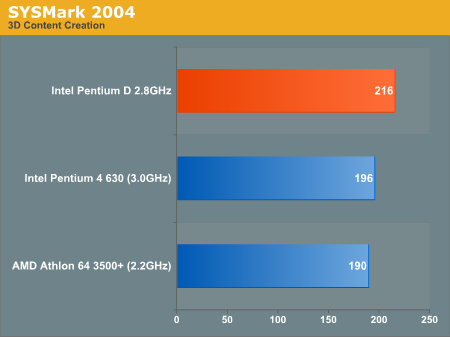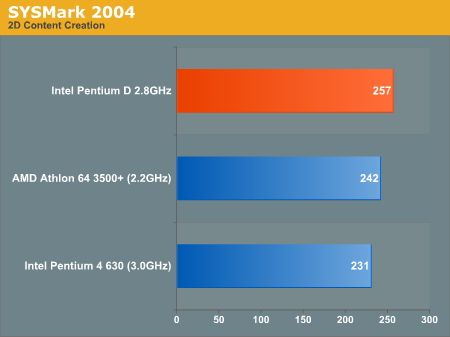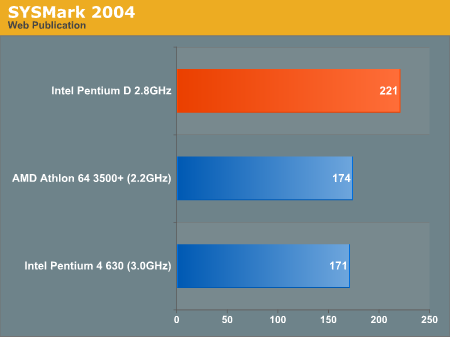Intel Dual Core Performance Preview Part II: A Deeper Look
by Anand Lal Shimpi on April 6, 2005 12:23 PM EST- Posted in
- CPUs
Multimedia Content Creation Performance
MCC Winstone 2004
Multimedia Content Creation Winstone 2004 tests the following applications in various usage scenarios:
- Adobe® Photoshop® 7.0.1
- Adobe® Premiere® 6.50
- Macromedia® Director MX 9.0
- Macromedia® Dreamweaver MX 6.1
- Microsoft® Windows MediaTM Encoder 9 Version 9.00.00.2980
- NewTek's LightWave® 3D 7.5b
- SteinbergTM WaveLabTM 4.0f
All chips were tested with Lightwave set to spawn 4 threads.

Once again, AMD's 3500+ takes the lead in the MCC tests, despite the benefits of dual core in the area.
ICC SYSMark 2004
The first category that we will deal with is 3D Content Creation. The tests that make up this benchmark are described below:
"The user renders a 3D model to a bitmap using 3ds max 5.1, while preparing web pages in Dreamweaver MX. Then the user renders a 3D animation in a vector graphics format."

Next, we have 2D Content Creation performance:
"The user uses Premiere 6.5 to create a movie from several raw input movie cuts and sound cuts and starts exporting it. While waiting on this operation, the user imports the rendered image into Photoshop 7.01, modifies it and saves the results. Once the movie is assembled, the user edits it and creates special effects using After Effects 5.5."

The Internet Content Creation suite is rounded up with a Web Publishing performance test:
"The user extracts content from an archive using WinZip 8.1. Meanwhile, he uses Flash MX to open the exported 3D vector graphics file. He modifies it by including other pictures and optimizes it for faster animation. The final movie with the special effects is then compressed using Windows Media Encoder 9 series in a format that can be broadcast over broadband Internet. The web site is given the final touches in Dreamweaver MX and the system is scanned by VirusScan 7.0."

SYSMark shows the exact opposite with the Pentium D taking the lead in all three of the ICC tests.










106 Comments
View All Comments
Umbra55 - Thursday, April 7, 2005 - link
Why do you still use the nForce 4 reference board for AMD tests? The real nForce 4 boards exist since over a quarter now and perform 10% better than the reference board. You also pretend to compare CPUs with similar price. Wouldn't it make more sense to compare combinations of mobo/CPU/memory of similar price?This is not a fair comparison (Or is it the intention?)
Umbra55 - Thursday, April 7, 2005 - link
yde - Thursday, April 7, 2005 - link
In this atricle, I was unable to find cache information about the AMD chip (usually equipped with a 512 KB L2 cache).To my point of view, in multiple threads scenario, the cache size may have dramatic influence and may explain several handicaps in the benchmarks. It would be nice to know what happens with a 1MB L2 cache Athlon 64 to keep things equal.
AMD chip has shorter branch prediction lines and seem quite well equipped for multitasking in theory, so why is it appearing so weak?
snorre - Thursday, April 7, 2005 - link
We're still waiting for proper benchmarks comparing dual core Smithfield with dual Opteron/Xeon. When will we see this?Comparing dual core CPUs with single core CPUs is like comparing apples and oranges, totally meaningless.
Calin - Thursday, April 7, 2005 - link
Thanks for the minimum frame rate comparison! And maybe you should not use so many flash-heavy pages, especially considering that you already told us that Athlon64 is much slower in Flash than Pentium4...Looks like Pentium D is a better choice in more ways than the Prescott is
xsilver - Thursday, April 7, 2005 - link
The multitasking gaming analysis combined with HT and NCQ was very insightful, almost pioneering...and with dual core AMD's people have to remember that the whole architecture is designed differently, and hence the possible suprises in tasks that the pentium D may not perform well on
but the power consumption advantage on amd is mighty tempting as amd will be the cpu that just keeps on saving -- with power bills that is
Azsen - Thursday, April 7, 2005 - link
Hi Anand,I was thinking, seeing most games are single-threaded you might like to try and benchmark this scenario on the dual core machine:
Set all the processes including operating system processes and other background processes to run on CPU 0 (first core). Then set the particular game to run on CPU 1 (second core). Have nothing else but the game running on CPU 1. This should dedicate a whole CPU core to the game for maximum performance in theory. I believe you can set the affinity in the task manager or use a batch file to do it.
Then run a Doom3 benchmark or HL2 benchmarks to see if the gaming performance is increased by letting the single-threaded game have a whole CPU core with no interuptions.
Would this be feasible to test?
Cheers. :)
AnnoyedGrunt - Wednesday, April 6, 2005 - link
The AMD not competing with the PD 2.8 will be due to price.Remember that AMD will need to sell a 2 core 2.2 GHz processor for about double the price of the single core version (maybe even more if yields are a problem). Therefore, you should expect a dual core 2.2 proc to be closer to $500-600 instead of the ~$300 processors tested here.
This also explains why AMD is focusing on the workstation market first. It's an area where price is typically not as much a factor, and where they are competing with Xeon prices, so it will be much easier for them to sell procs @ the higher prices.
I'm guessing that AMD's desktop dual core procs will start @ 1.6 or 1.8 GHz, and be priced on par with the Intel offerings. I think the overall performance will be similar to the current single core behavior, but now you can have more stuff running.
I currently have an AMD 939 3200+, so I am looking forward to their dual core offerings in a couple years, and hoping my mobo will be compatible. That would be very cool.
Also, I would like to add vote for a WoW test with Teamspeak running in the background as well as an istance if IE or Firefox with tthotbot.
Thanks,
D'oh!
SLIM - Wednesday, April 6, 2005 - link
Hi Anand,Any chance you could give us a little peak at what dual opterons on the nforce pro chipset can do in the same benches that you did in this article.
A configuration something like this:
Opteron 252s clocked at 1.8GHz, 2.2GHz, 2.6GHz
1 GB ECC DDR400
NVIDIA nForce pro motherboard
ATI Radeon X850 XT PCI Express
NCQ enabled HDD (maxline III, 7200.8, etc)
I looked through all the old articles I could find, but most seemed to contain only server oriented benches. I think that kind of article would be very enlightening as to the future performance of dual core athlons (probably within a couple percent)... maybe help put to rest some of the questions a lot of us have about waiting for amd dualcore, intel dualcore or just overclocking the heck out of a venice a64.
SLIM
Jep4444 - Wednesday, April 6, 2005 - link
SSE3 does almost nothing for the Venice which is barely faster than the Winchester(Xbit Labs benchmarked it already)While Anandtech said the dual cored A64s wouldn't compete with the Pentium D in encoding, unless they actually have dual cored A64s which they can't show us, i'd be willing to argue with that. Encoding is one of those things thats largely affected by Hyper-Threading and the Pentium D loses hyper threading. When the A64 goes dual, its performance increase will be larger than Intels.